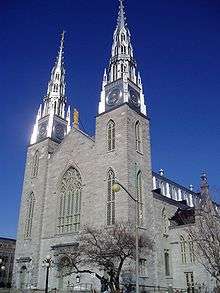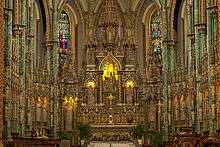Notre-Dame Cathedral Basilica (Ottawa)
| Notre-Dame Cathedral Basilica | |
|---|---|
 | |
 Notre-Dame Cathedral Basilica | |
| 45°25′47″N 75°41′47″W / 45.42971°N 75.69646°WCoordinates: 45°25′47″N 75°41′47″W / 45.42971°N 75.69646°W | |
| Location |
385 Sussex Drive Ottawa, Ontario K1N 1J9 |
| Denomination | Roman Catholic |
| Website | Official site |
| Architecture | |
| Status | Minor basilica (from 1879) |
| Functional status | Active |
| Heritage designation | National Historic Site |
| Designated | 1990 |
| Style |
Neoclassical Gothic Revival |
| Years built |
1841–1865 1876–1885 (interior)[1] |
| Specifications | |
| Number of spires | 2 |
| Administration | |
| Archdiocese | Ottawa |
| Clergy | |
| Archbishop | Most Reverend Terrence Prendergast, S.J. |
| Rector | Mgr Daniel Berniquez, v.e. |
| Laity | |
| Director of music | Michel Guilmont |
| Organist(s) |
Jennifer Loveless |
| Official name | Notre-Dame Roman Catholic Basilica National Historic Site of Canada |
| Designated | 1990 |
| Type | Municipal Heritage Designation (Part IV) |
| Designated | 1978 |
The Notre-Dame Cathedral Basilica is a Roman Catholic minor basilica in Ottawa, Canada located on 385 Sussex Drive in the Lower Town neighbourhood. It was designated a National Historic Site of Canada in 1990.[2][3]
History and architecture

The site was originally home to the small wooden St. Jacques Church built in 1832. This structure was destroyed in 1841 to make way for a larger church, designed by local builder Antoine Robillard and Father John Francis Cannon who requested a Neo-classical design.[4]
However, in 1844, after the lower section was completed, the Oblate Fathers (OMI) assumed stewardship of the parish and Father Pierre-Adrien Telmon was sent from France to finish the construction.[5] Father Telmon decided to redesign the church into a Neo-Gothic structure, a style which was growing in popularity.[6] This resulted in the lower features, such as the main entrance, being Neo-Classical, while the upper portions of the structure are Neo-Gothic.[4]
The main structure was completed in 1846. In 1847, the church was designated the cathedral of Bytown and Joseph-Bruno Guigues was appointed the first bishop. He is honoured with a lifesize statue at the southwest corner of the cathedral grounds.[7] In 1859, Father Damase Dandurand, OMI, designed the two Gothic spires which were added to the west front in 1866. Earlier, in 1849-50, he designed the Archbishop's Palace and in 1862-63, added the choir loft.[8] In 1879, Pope Leo XIII designated the cathedral as a minor basilica.
The steeples are covered with tin, which is typical for French-Canadian churches, and house a peal of bells. The exterior is fairly reserved, but the interior is as far more ornate, designed by Georges Buillon. The interior of the church is brightly painted and decorated with carved features, exquisite stained glass windows and hundreds of statues of various religious figures. Louis-Philippe Hébert completed thirty large wooden sculptures in the choir. At the end of the choir, the Holy Family is completed with saints John the Baptist and Patrick, the patron saints of French and Irish Catholics.[9]
James R. Bowes, architect, designed new galleries and other improvements in 1875.[10]
The Basilica is the oldest and largest church in Ottawa and the seat of the city's Roman Catholic archbishop. Its twin spires and gilded Madonna are easily identifiable from nearby Parliament Hill and the surrounding area. The church was last renovated and restored in the late 1990s. Services are held in both French and English.
Governor General Georges Vanier and Prime Minister Sir Wilfrid Laurier both were given state funerals at the Cathedral.
Plaques
"1841-1843 - This Gothic revival structure is the oldest surviving church in Ottawa. Its twin steeples were erected in 1842. In 1848 it was named the Cathedral of the Diocese of Ottawa, then later was granted the titile Basilica. Its chief glory is its carved and painted interior. Designated heritage property 1978." [11]
"On Dec 18 1999 the most reverend Marcel A Gervais, Archbishop of Ottawa officially reopened Notre Dame Cathedral. The Cathedral had been closed for renovations since the beginning of 1999 and work continued into the year 2000. This historic restoration was made possible through the generous gifts of anonymous donors, the Canada Millenium partnership program, the Ontario Government and the friends of the Cathedral. We also recognize the warm hospitality of the Sisters of Charity of Ottawa who welcomed the community at the Chapel of their Mother House while the Cathedral was closed." [12]
Organs
The first organ is inaugurated on March 7, 1850 by Damis Paul, organist at Montreal's cathedral. The instrument had been partially installed in 1848 for Bishop Guigues' consecration. Joseph Casavant built an 18-stop instrument (1,063 pipes) and placed it in a case that was later sculpted by Flavien Rochon in 1871. The instrument was restored by organbuilder Louis Mitchell a few years later. Casavant’s sons completely reconstructed the organ in 1892. At that time, it is a 52-stop instrument over 3 manuals and pedal. The instrument used an electro-pneumatic action which represented a new summit for the Casavant firm. The main section of the organ is located in the rear gallery while a second organ, a 17-stop choir organ over 3 manuals and pedal, is located in a gallery over the sanctuary. Both organs are played from the console located in the rear gallery.
This instrument is one of the three outstanding instruments in the history of the Casavant firm, the others being the one in Notre Dame Basilica in Montréal (1890) and the one in St. Hyacinthe Cathedral (1885).
Originally the console was attached to the left organ case. From the very beginning, the organ case is divided into two sections in order to free the magnificent stained-glass window. New stops were added in 1917. A second console, more modern, was installed in 1940 when a major rebuilt was undertaken and, in 1975, a revision of the electric action was carried out.
In 1999, Guilbault-Thérien carried out a major renovation, replacing the second console, and adding 7 more stops in order to achieve a better balance amongst the divisions while respecting the symphonic aesthetics of the instrument. The chancel organ still retains its original composition and voicing.
Composer Amédée Tremblay notably served as the church's organist from 1894-1920.[13]
The present titular organist is Jennifer Loveless.
Gallery
 Madonna atop Basilica
Madonna atop Basilica Louis-Philippe Hébert's statue of Bishop Joseph Eugene Guiges outside Notre-Dame Cathedral Basilica, Ottawa
Louis-Philippe Hébert's statue of Bishop Joseph Eugene Guiges outside Notre-Dame Cathedral Basilica, Ottawa Interior of Notre-Dame Cathedral Basilica
Interior of Notre-Dame Cathedral Basilica.jpg) View from Major's Hill Park
View from Major's Hill Park The Nave
The Nave The Vaulted Ceiling
The Vaulted Ceiling Stained glass above the organ
Stained glass above the organ
See also
References
- ↑ Architecture — History
- ↑ Notre-Dame Roman Catholic Basilica, Directory of Designations of National Historic Significance of Canada
- ↑ Notre-Dame Roman Catholic Basilica National Historic Site of Canada. Canadian Register of Historic Places. Retrieved 3 February 2012.
- 1 2 Kalman, 31.
- ↑ Yvon Beaudoin, o.m.i. "Telmon, Pierre Antoine Adrien". OMIworld.org. Retrieved 2013-09-25.
- ↑ Fletcher, 61.
- ↑ "History of the Church". Notre Dame Cathedral Basilica. Retrieved 2013-09-25.
- ↑ Hill, Robert G. (2009). "Rev. Damase Dandurand". Biographical Dictionary of Architects in Canada 1800-1950. Retrieved 2013-09-25.
- ↑ Kalman, 32.
- ↑ "James R. Bowes". biography in Biographical Dictionary of Architects in Canada 1800-1950. Retrieved November 16, 2011.
- ↑ Heritage Trust - plaque
- ↑ Heritage Trust -plaque
- ↑ Gilles Potvin. "Amédée Tremblay". The Canadian Encyclopedia. Retrieved 25 April 2010.
- Bibliography
- Fletcher, Katharine (2004), Capital Walks: Walking Tours of Ottawa', Markham, Ontario: Fitzhenry & Whiteside,
- Kalman /Roaf, Harold / John (1983), Exploring Ottawa: An Architectural Guide to the Nation's Capital., Toronto, Ontario: University of Toronto Press
- Anon (1983), Répertoire des mariages de la Cathédrale d’Ottawa (1827-1980), Ottawa, Ontario: Le Centre de généalogie
External links
| Wikimedia Commons has media related to Notre-Dame Cathedral Basilica. |
- Official website
- Organ Specifications and Photos entre
- GCatholic.org entry
- Notre-Dame Cathedral Basilica photos.
- Notre Dame Roman Catholic Basilica HistoricPlaces.ca
